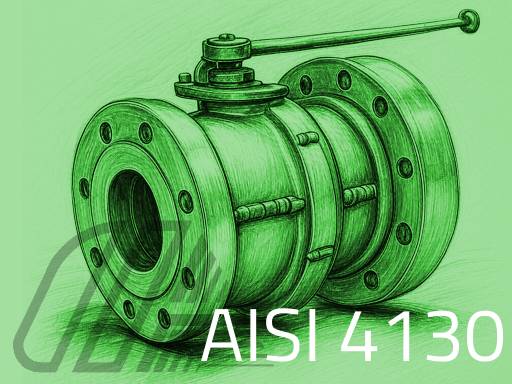AISI 4130
ASTM A29
Quenced Tempered (+QT)
PROPRERTIES AND APPLICATIONS
AISI 4130, also known as SAE 4130 or 25CrMo4 in the European EN 10250 standard, is a low-alloy, medium-carbon steel celebrated for its excellent strength-to-weight ratio, weldability, and versatility. This chromium-molybdenum alloy steel is a staple in industries requiring components that can withstand high stress while maintaining good toughness and machinability.
AISI 4130 offers high strength while remaining relatively lightweight, making it ideal for applications where weight reduction is critical, such as in aerospace. The presence of chromium and molybdenum allows the steel to be hardened through its cross-section, though its hardenability is lower than that of AISI 4140, making it better suited for smaller sections. AISI 4130 maintains good toughness and ductility, even after heat treatment, ensuring it can withstand impact and dynamic loads.

Common Applications of AISI 4130:
Aerospace Industry: AISI 4130 is widely used in the aerospace sector for components like aircraft structural parts, landing gear, and engine mounts. Its high strength-to-weight ratio and ability to withstand fatigue make it ideal for these critical applications. For example, it is often used in the construction of airframes and roll cages for experimental aircraft.
Oil and Gas Industry: In the oil and gas sector, AISI 4130 is used for components like wellhead equipment, valve bodies, and tubing. Its ability to resist stress corrosion cracking and perform under high-pressure conditions makes it suitable for downhole applications, such as in seamless pipes for drilling operations.
Automotive and Motorsport: AISI 4130 is a favorite in the automotive and motorsport industries for parts like roll cages, suspension components, and chassis frames. Its weldability and strength make it ideal for fabricating lightweight, high-performance structures, such as those used in race cars and off-road vehicles.
Pressure Vessels and Piping: AISI 4130 is often used in the fabrication of pressure vessels, fittings, and piping systems, especially in the energy sector. Its ability to be welded into complex shapes while maintaining strength ensures reliability in high-pressure environments.
General Engineering: The steel is frequently used in general engineering for components like shafts, gears, and fasteners. Its balanced properties make it suitable for applications requiring moderate strength and good fatigue resistance, such as in machinery and industrial equipment.
AISI 4130 is often compared to AISI 4140, which has a higher carbon content (0.38–0.43%), AISI 4130 is more weldable but has lower strength and hardenability, making it better suited for smaller sections or applications where welding is a priority. AISI 4340, with added nickel, offers greater toughness and is better for high-impact applications, but it is more expensive and harder to weld than 4130.
When working with AISI 4130, manufacturers must consider several factors. Its weldability is a significant advantage, but proper preheating and post-weld heat treatment are necessary to avoid issues like cracking, especially in thicker sections. While the steel has some corrosion resistance due to its chromium content, it is not immune to rust and may require coatings or oiling in corrosive environments.
CORRESPONDENCE TO INTERNATIONAL DESIGNATIONS
| QUALITY | EUROPE | GERMANY | FRANCE | SPAIN | G.B. | USA | |
|---|---|---|---|---|---|---|---|
| EN | DIN | W.n. | AFNOR | UNE | B.S. | AISI/SAE | |
| AISI 4130 | ~25CrMo4/~30CrMo4 | 1.7218 | 708A25 | 4130 | |||
CHEMICAL ANALYSIS
| STEEL DESIGNATION | CHEMICAL ANALYSIS | ||||||||
|---|---|---|---|---|---|---|---|---|---|
| SYMBOLIC | C | Mn | Si | P max | S max | Cr | Mo | V | Al max |
| AISI 4130 | 0,28 ÷ 0,33 | 0,40 ÷ 0,60 | 0,15 ÷ 0,35 | 0,035 | 0,040 | 0,60 ÷ 1,10 | 0,15 ÷ 0,25 | - | - |
MECHANICAL CHARACTERISTICS
| STEEL | d ≤ 16mm | 16mm < d ≤ 40mm | 40mm < d ≤ 100mm | 100mm < d ≤ 160mm | |||||||||||||
| SYMBOLIC | NUMERIC | Re min | Rm | A min | KCU min | Re min | Rm | A min | KCU min | Re min | Rm | A min | KCU min | Re min | Rm | A min | KCU min |
| N/mm2 | % | J | N/mm2 | % | J | N/mm2 | % | J | N/mm2 | % | J | ||||||
| AISI 4130 | 1,7218 | 685 | 880 ÷ 1080 |
12 | 32,5 | 635 | 830 ÷ 1030 |
12 | 32,5 | 520 | 740 ÷ 880 |
13 | 30 | 420 | 690 ÷ 830 |
15 | 30 |
JOMINY HARDENABILITY
| STEEL DESIGNATION | RANGE LIMITS | HRC HARDNESS MEASURED FROM THE QUENCHED END OF THE TEST TUBE (MM) | |||||||||||||
|---|---|---|---|---|---|---|---|---|---|---|---|---|---|---|---|
| SYMBOLIC | NUMERIC | 1,5 | 3 | 5 | 7 | 9 | 11 | 13 | 15 | 20 | 25 | 30 | 35 | 40 | |
| AISI 4130 | 1.7218 | max | 56 | 55 | 53 | 51 | 49 | 47 | 45 | 42 | 39 |
37 |
35 | 33 | 32 |
| min | 46 | 45 | 42 | 38 | 35 | 30 | 28 | 26 | 24 | 23 | 21 | 20 | - | ||
USUALLY AVAILABLE EX STOCK
| M.T. COLORATION | QUALITY | HEAT TREATMENT | SURFACE | DIAMETER (mm) |
|---|---|---|---|---|
| AISI 4130 | Quenched and tempered | rolled | 40-400 |






